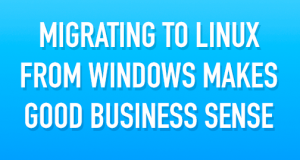What Does It Really Cost To Adopt Linux?
Look At Existing Use
Before getting into an abstract cost-benefit analysis, look around a bit and see if Linux has already crept into your company’s IT infrastructure.
In many cases, Linux may already be there unobtrusively, running under, say, a small department’s intranet. You may also want to look around and see if some staff members are running Linux at home for telecommuting purposes. A lot of high-tech people have a Linux box at home and access a corporate intranet.

If you find that Linux is already present in your computing infrastructure, don’t miss the opportunity to learn from practical experience. Find out how Linux has been performing in your environment and what resources are needed to adjust its performance to the optimum level, be they hardware, software, staff support or user training.
If you multiply out what these costs are, you’ll begin to get a crude but still useful sense of what the cost drivers would be in a larger Linux installation. While telecommuting use or low-volume intranet installations aren’t on a par with, say, running all of your network services over Linux, looking at how they’re doing is at least someplace to start. Gauging Performance Needs
The cost of bringing in Linux will vary, depending on what exactly you need to get done. Before making any cost calculations, decide what applications you’ll be implementing and what performance levels they’ll need to achieve.
If you’re thinking about running Linux under your Web server, for example, you might consider how many users you’re going to support. If you’re going to support transactions, the key issue may be how many transactions per second have to pump through per minute, per user session or some other relevant measure.
Hardware Needs
Bear in mind that your hardware requirements may change if you move to Linux. “You can’t compare apples to apples,” says Laurent Meynier, chief executive officer of San Francisco-based open source consulting firm Olliance. “Maybe the hardware that you need to get the same performance from Linux is different than hardware that Windows requires.”
Another issue to consider is whether you are ready to buy Linux-installed hardware or plan to use your existing infrastructure. Enterprises can cut down on the need for costly Linux consultants by buying hardware with the OS pre-installed, a step both Tiemann and Meynier strongly recommend.
Who’s On Your Team?
Another important step is to evaluate what it will take to get support from IT staff members for your Linux strategy. Your cost for building a Linux team could be as modest as some support and pats on the back for Linux-friendly tech staff, or as costly as bringing in a certified expert or three and paying the top-dollar compensation they can command.
If staff members are already somewhat familiar with Linux — or flexible enough to begin learning about it — it may be easier to get the ball rolling. Young staff members fresh out of college, in particular, may have “grown up” with Linux as it came into prominence over the past few years. What’s more, Linux is especially popular in college and university settings, according to Tiemann.
Training Cost
If your staff members are particularly motivated, or already have some grounding in Linux stuff, there’s always the wealth of open source tips, tactics, and collegial support available over the Net. That is, of course, the cheapest way to get your staff rolling.
Formal training is another matter. Linux training and certification options are multiplying. Prices vary, and some training outfits merely stamping a seal of approval on skills the user must develop primarily on their own.
Perhaps the most intense training comes from RedHat, whose Red Hat Certified Engineer (RHCE) program was based on Microsoft’s MSCE curriculum. For courses which start at about $2,500, IT staffers learn just about everything they’d need to keep a Linux installation functioning effectively.
External Support Costs
Finally, bear in mind that vendor support costs are almost always a part of the equation. Before you scope out support costs, you’ll need to know whether you need day-to-day help or just a helping hand now and then. One of the key factors influencing the cost of vendor support will be whether you want to go a la carte or by the contract.
Prices for a la carte, per-incident support vary, of course. Independent support vendor Linux Support Services, for example, range $100/hour to as much as $200/hour if you need an immediate response. Yearly support prices also range widely. Linux Unlimited, for example, offers a range of plans scaling up from $499 per year for e-mail-only support to $3,500 per year for their “Gold” annual package. Linux systems vendors, meanwhile, typically offer per-incident, per-year, and on-site consulting options.
Per-incident support may be good enough for companies that have a strong base of Linux expertise, but a long-term contract will probably be necessary for most others.
“Companies do need to be able to support their own infrastructure, but when it comes to components and tools in the infrastructure, company is wise to go to the original manufacturer,” Tiemann suggests.
Every company has different needs, of course, but the factors I’ve listed here will help get you started on the right foot when you look at using Linux in your organization.